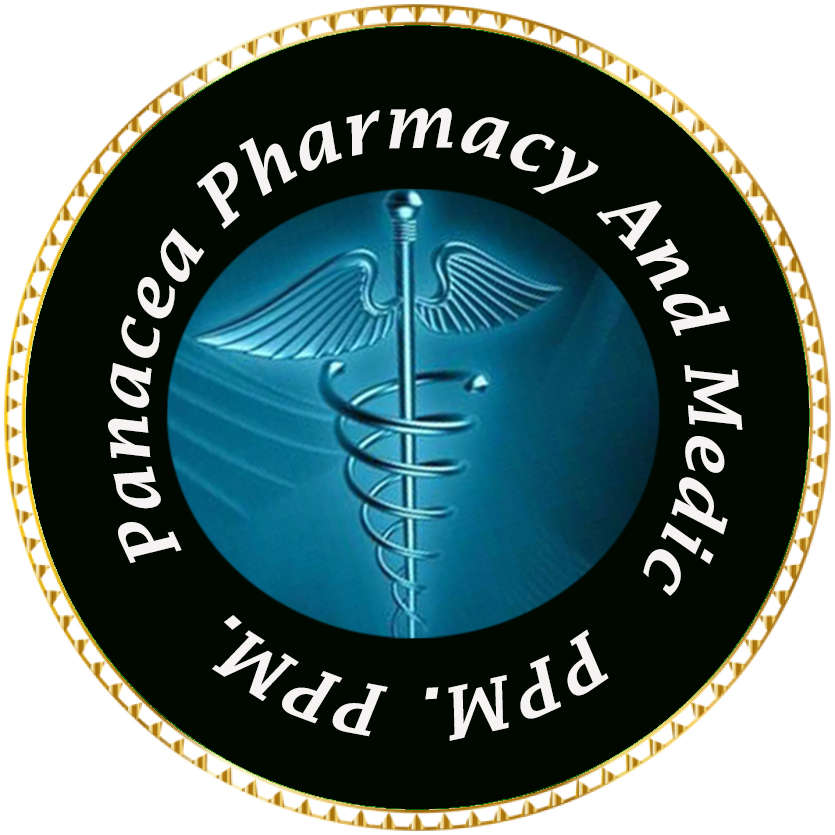Diabetes mellitus
Diabetes mellitus as a group of of metabolic disorder characterized by in appropriate hyperglycemia resulting from effect of insulin secretion insulin action or both. Symptoms include poly-urea, polydepsia, weight loss, blurred vision, fatigue, headache and poor wound healing. Chronic hyperglycemia may lead organ damage like kidney, heart , blood vessel and nerve.
Classification
Actually there are three types
- Type 1 ( Insulin dependent)
- Type 2 (Insulin independent)
- Gestational diabetics
Prediabetic
Prediabetic is the condition that may risk to develop the diabetic .
Evolution
- Impaired fasting blood glucose (IFG)= 100 to 125 mg/dl.
- Impaired glucose tolerance (OGT ) O G T T = 100 to 199 mg/dl.
- HbAc1= 5.7% to 6.4%.
- It is very important to be alert from the diabetic. If you take the necessary steps and modify your lifestyle you should free from the risks of diabetics.
Diet of diabetic patient
Very important for all the Diabetic patients. food are calculated by Consuming carbohydrate, fat and protein.
Carbohydrates
- Carbohydrates consume not exceed 45 to 60% of Total energy intake.
- 70% carbohydrate should be non starchy eg. Broccoli, collards, beans, pluses, etc.
- 30% carbohydrates may be starchy eg. breads rice potatoes etc.
Fat
- Should not consumed exceed 30% of Total energy Intake.
- Saturated fat try to leave. More mono saturated fat Should be selected eg. olive oil .
- Trans saturated fat not exceed 10% of total fat consuming eg. Soybean oil, seed oils.
Proteins
For adults without nephropathy protein less than 1 g per kg not more than 20% of Total energy intake.
Food take can a plate method
Standard size dinner can be calculate
- 1/2 of plate non starchy vegetable eg.Broccoli, salad, cabbage, calards etc.
- 1 /4 of plate starchy food eg. bread, rice, potatoes, noodles etc.
- 1/4 of plate by meat eg. 3 oz of cooked meat.
- I suggest it is better to take a whole meal of a day dividing by 5 times by small small portion.
Exercise
It should be mild or moderate aerobic exercise. At least 150 min per week. Daily work and free hand exercise can reduce you insulin resistance to the cell.
Weight control
- Body weight should be less than BMI= 20 to 25 kg/m2.
- Waist circumference for female < 88 cm and male < 102 cm.
- Who are already overweight and affected diabetes should reduce 10 to 15% of total body weight. Fat of adipose tissue resistance to insulin.
- If fat reduction, diet and exercise don’t control blood glucose should help the medication.
- Pre-Diabetics patients should conscious about their diet and lifestyle.
Home remedy
Home remedy is very important for diabetic’s patient who is specially pre-diabetics patients. Who is diabetic’s patient home remedy is very helpful as co-administration with other medicine. Primary mild diabetic’s patients generally treated with home remedy instead of medicine and moderate and severe diabetic’s patients should co-administration with other medicine.
Primarily I suggested three important herb that very helpful for reducing blood glucose level.
-
Coccinia
It is a herb plant scientific name is Cephalandra and botanical name is Coccinia Cordifolia Cogn. These plant are found in anywhere in Bangladesh.Locally in Bangladesh it is called কুচিলা, তেলা, তেলাকচু, তেলাহচি, তেলাচোরা কেলাকচু, কেলাকুচ, তেলাকুচা বিম্বী ইত্যাদি নামে ডাকা হয়. It is very important for lowering blood glucose level. Everyday 150 gm green Cephalandra leave or its juice in empty stomach is very important for lowering blood glucose level.
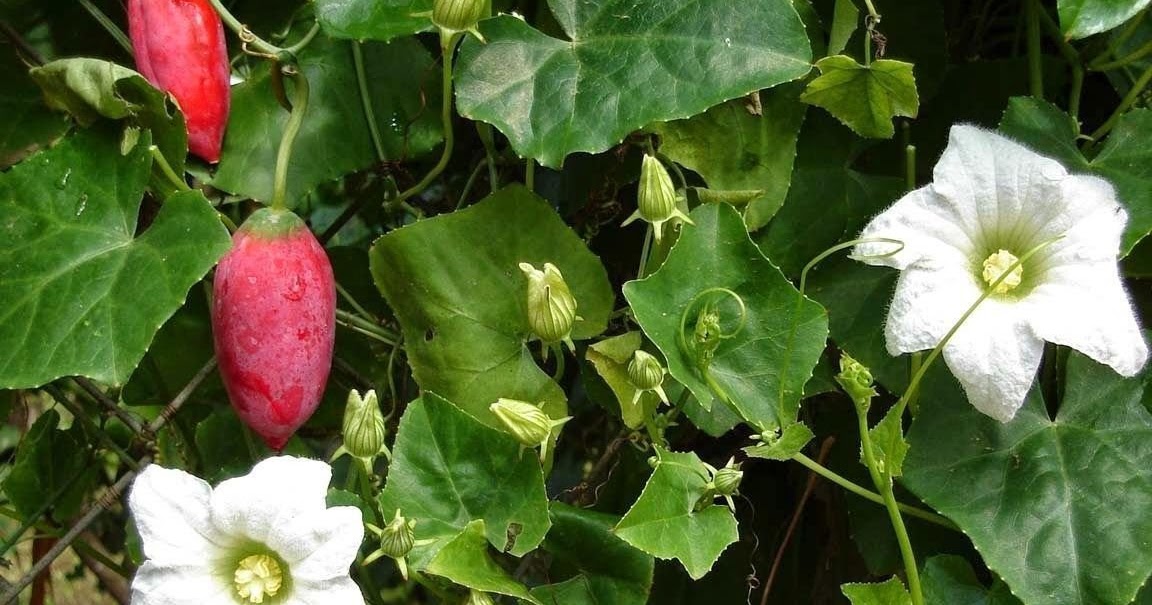
Cephalandra
2. Gourd
The gourd is the most useful vegetable for lowering the blood glucose level. There are lots of English name as like Balsam pear, alligator pear, bitter gourd, bitter melon, bitter cucumber etc. It’s scientific name is Momordica charantia family Cucurbitaceae. In Bangladesh it is called by করল্লা, উচ্ছা, উচ্ছে etc. It is bitter test but has most active ingredients reducing blood glucose level. There are lots of species almost all species have same effects. Daily 100 mg green gourd juice or 150 mg fry Gourd is as a dose for lowering blood glucose level.

3. Syzygium cumini
The scientific name of Syzygium cumini is commonly known as Malabar plum, Java plum,black plum, jamun, jaman, jambul, jambolan etc. Its family is Myrtaceae. Syzygium cumini seeds has blood lowering effect. Daily 2-4 teaspoon Syzygium cumini powder play a very important role to lowering blood glucose level. I suggested mornig and evening 2 teaspoon Syzygium cumini powder may use individually.
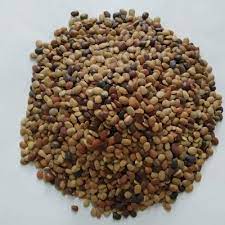
Syzygium cumini seeds
Type 1 diabetic
Characterized by absolute insulin deficiency auto immune destruction Beta cell Of the islets of Langerhans.
Diagnosis
Symptoms include poly-urea, polydipsia, weight loss, fatigue etc.
Test result
- FBG= >7 mmol/l
- ABS=>11 mmol/L
- 1 hours after 75g anhydrous ingestion.
- HbAc1=>6.5%
Treatment
In early stages treatment may be immunosuppressive agent like cyclosporine, azathioprine, prednisolone, antithymocyte globulin, etc.
Anti-CD3 monoclonal antibody are very useful preserve B-Cell islets of Langerhans.
Medication
For type 1 diabetes patient insulin is the main medicine
I prefer medication as insulin Premix insulin
70/30 70% of NPH with 30% regular insulin
Dose Adjustment
2 times daily – Two third used Prior to breakfast and one portion is evening prior to meal. eg. 21 units in morning and 11units to evening of total 32 units.
Calculation of insulin units
6 unit/ kg per day.
Use long acting insulin
eg. Insulin glargine or determir. 5 units per day with meal.
In type 1 Diabetes patient glucagon-like peptide 1 is a very helpful therapy co-administration with insulin. eg. Exenatide may be used.
Ketoacidosis
Uncontrolled production of ketones bodies.
Causes
Lack of insulin body tried to Utilize fat as a fuel source of energy then form excess Ketone bodies .
Symptoms
- Sweating
- Tachycardia
- Palpitation
- Fatigue
- Loss of concentration
- Confusion
- Hunger, headache first
Diagnosis
Confirm in laboratory test
- Glycosuria and Ketone urea
- Glucose, urea, creatinine, electrolyte, Venous Bicarbonate would be increase
- Distinct glucose test show 22 mmol/l.
Treatment of ketoacidosis
- Expand fluid volume ( 0.9% sodium chloride)
- Infusion insulin
- Prevent hyperkalemia
Type 2 diabetes
Insulin independence, basically cells are resistant to insulin, maximum time it is genetic.
Glycemic management of type 2 diabetes patient
Prevent further of major organs damage it should be strictly glycemic control. It would be better by controlling bellow HbAc1=6.5%.
Treatment goal should be
- If HbAc1 range is 6.5% to 7.5 %.
- Metformin is the first choice if no contraindication, try two to three months as mono therapy. If not glycemic control then second medicine would be added. Choice of second medicine would be better of sulphonylureas group. eg. glacazid.
- If HbAc1 range is 7.62% to 9% Medicine should be added with metformin as double or triple therapy. If second (Sulphonyl urease) or third(Thiazolidinediones) or DPP4 inhibitor drug are contraindicated to reduce HbAc1 < 8.5 % then insulin is added.
- If triple therapy failed to reduce hyperglycemia insulin is directly administrate alone or with anti-hyper glycemic agent.
Diabetics mellitus treated by best antihyperglycemic agent
Biguanides
Metformin
It is first line therapy. It is very effective and safest. If patient are not acute cardiac failure, acute renal disease, acute liver damage record metformin should the first choice.
Dose adjustment
500 mg daily a week initiate the dose. Then 500 mg twice daily. Then increase if needed. Maximum dose is 3g per day. Modified release preparation are available and dose is one per day.
Adverse effect
- Abdominal discomfort is the main adverse effect
- Bolting is another
- Diarrhea may be occurs
Contraindication
- Should not prescribed for patients who have renal impairment eGFR < 45 ml per minute/1.73 m2.
- Should stop In anyone with an eGFR less than 30 ml per minute/1.73 m2.
- Should be considered as cardiac failure serial pulmonary insufficiency.
Sulphonyl urease
Gliclazide
It is the best medicine of this group and most beneficial.
Dose adjustment
- Initiate with low dose for 2 weeks.
- 1 to 2 times daily 30 minute before to meal.
- Modified release drugs are available 30 mg modified release drug are equivalent to 80 mg.
Adverse effect
- Hypoglycemia is common complain
- Weight gain
- Hyponatremia
- All of studies medicine of this group is best choice.
Thiazolidinediones
Very effective antihyperglycemic but have a lots of contraindication to use.
Pioglitazone
It is very effective drugs of this group. significant beneficial on macro-vascular morbidity and mortality. This types of medicine are third line therapy.
Dose adjustment
Initiate 15 mg maximum 45 mg per day in ones with or without meal for 6 months therapy. Should stop after reduce HbAc1 =0.5%.
Adverse effect
- weight gain
- Edema
- Bone fracture
- Heart failure
Contraindication
- Should not treat it hypertensive And heart failure patient
- Caution should be taken for postmenopausal women
- Caution should be taken co-administration with insulin it may cause edema.
- My suggestion is avoid this groups of medicine if possible.
Dipeptidylpeptidase-4 inhibitor
It is third line therapy and Newly added for this treatment purpose. Insulin resistance patient treated with thiazolinedione or alone. Co-administered with metformin.
Sitagliptin
It is the most potent and effective drug of this group.
Dose adjustment
100 mg par day with a single dose.
Adverse effect
- Gastrointestinal discomfort
- Upper respiratory tract infection.
- Liver dysfunction
Contraindication
should not used pancreatitis patient.
Some direct prescription are given bellow you can follow according to your health condition:
Prescription No 1 :
Apply for the patient condition – who are
- Mild diabetics type two patient
- If HbAc1 range is 6.5% to 7.5 %.
By using self measurement of blood glucose level
- FBG= 7 to 12 mmol/l
- ABS=11 to 16 mmol/L
- 1 hours after 75g anhydrous ingestion.
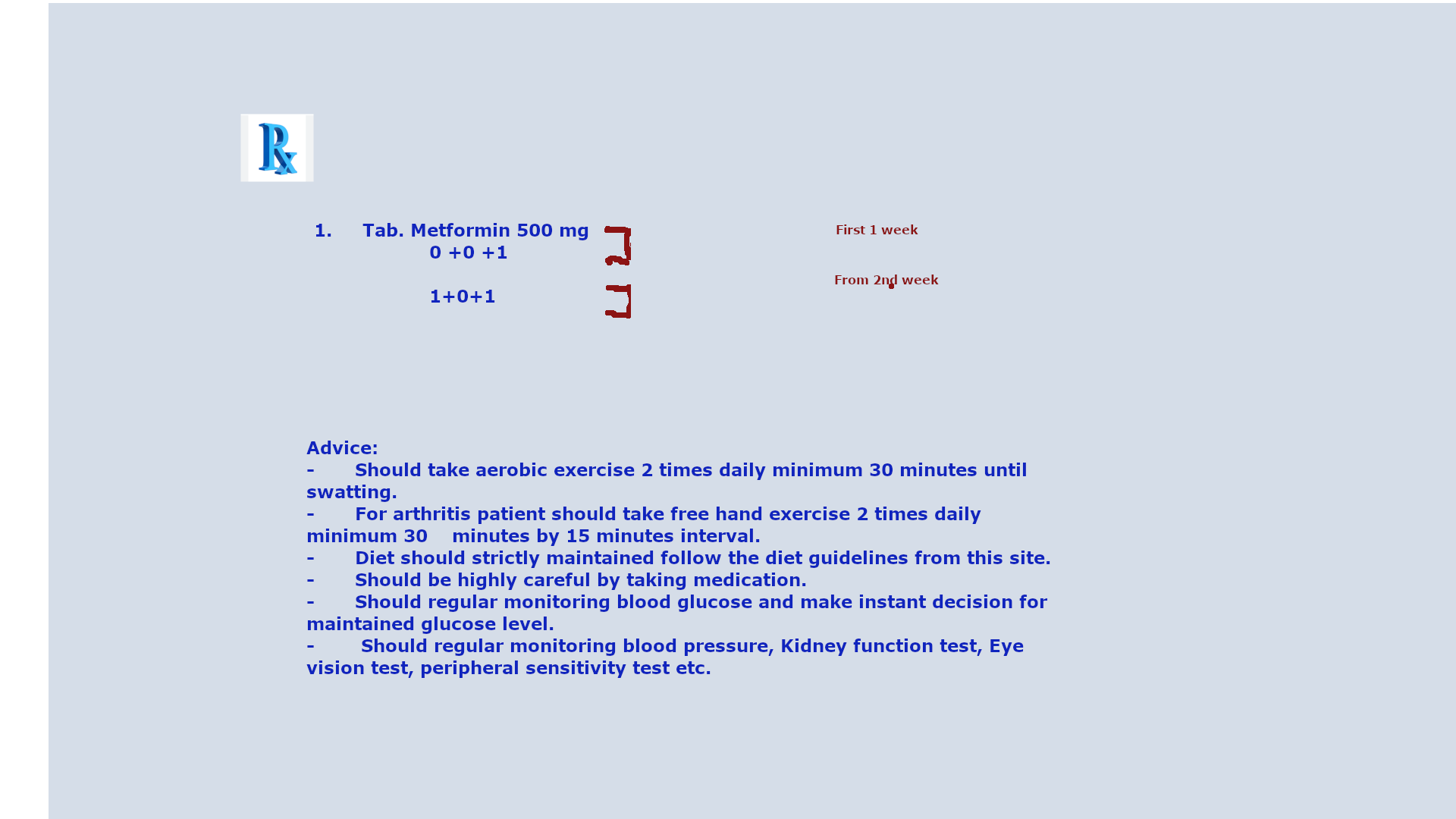
Picture 1 : Prescription No 1
Prescription No 1 Contraindicated to the patient- Who are
- Should not prescribed for patients who have renal impairment eGFR < 45 ml per minute/1.73 m2.
- Should stop In anyone with an eGFR less than 30 ml per minute/1.73 m2.
- Should be considered as cardiac failure serial pulmonary insufficiency.
Note: Dose should be adjustment according with blood glucose level. If your self measurement FBG bellow 7 mmol/L and ABS bellow 11 mmol/L or HbAc1 bellow 6.5% you should reduce dose in single dose metformin 500 mg a day or avoid medicine and by strictly diet control with exercise .
Prescription No 2 :
Apply for the patient condition – who are
- Mild diabetics type two patient
- If HbAc1 range is 6.5% to 7.5 %.
- Who are a kidney disease patient
By using self measurement of blood glucose level
- FBG= 7 to 12 mmol/l
- ABS=11 to 16 mmol/L
- 1 hours after 75g anhydrous ingestion.
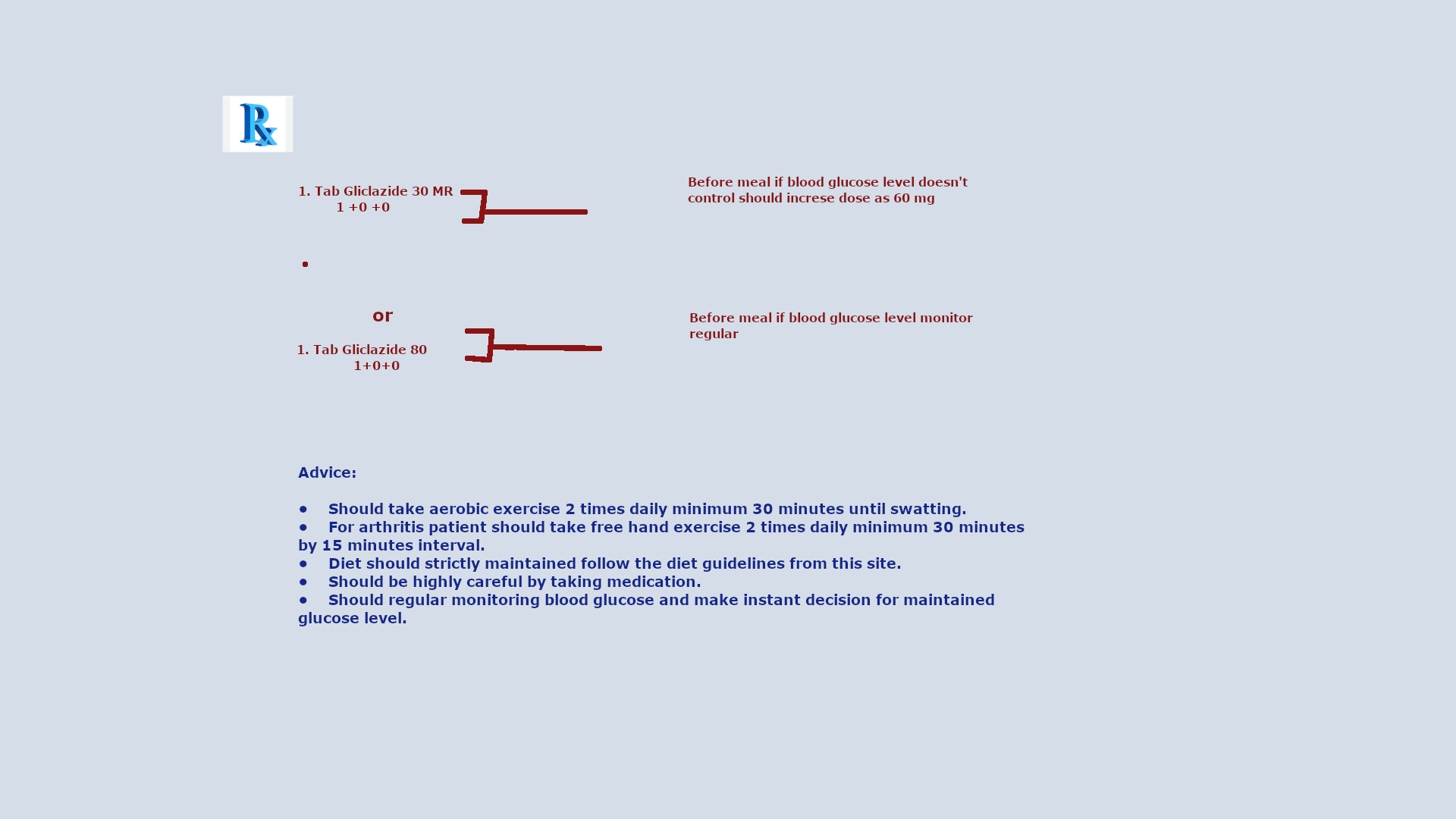
Note: Dose should be adjustment according with blood glucose level. If your self measurement FBG bellow 7 mmol/L and ABS bellow 11 mmol/L or HbAc1 bellow 6.5% you should reduce dose in single dose Glicazide 30mg MR a day or avoid medicine and by strictly diet control with exercise .
Prescription No 2 Contraindicated to the patient- Who are
- It is best selection medicine no other contraindicated though hypoglycemia is the major risk and should conscious about that.
Prescription No 3
Apply for the patient condition – who are
- Moderate diabetics type two patient
- If HbAc1 range is 7.5% to 8.5 %.
By using self measurement of blood glucose level
- FBG= 12 to 16 mmol/l
- ABS=16 to 20 mmol/L
- 1 hours after 75g anhydrous ingestion.
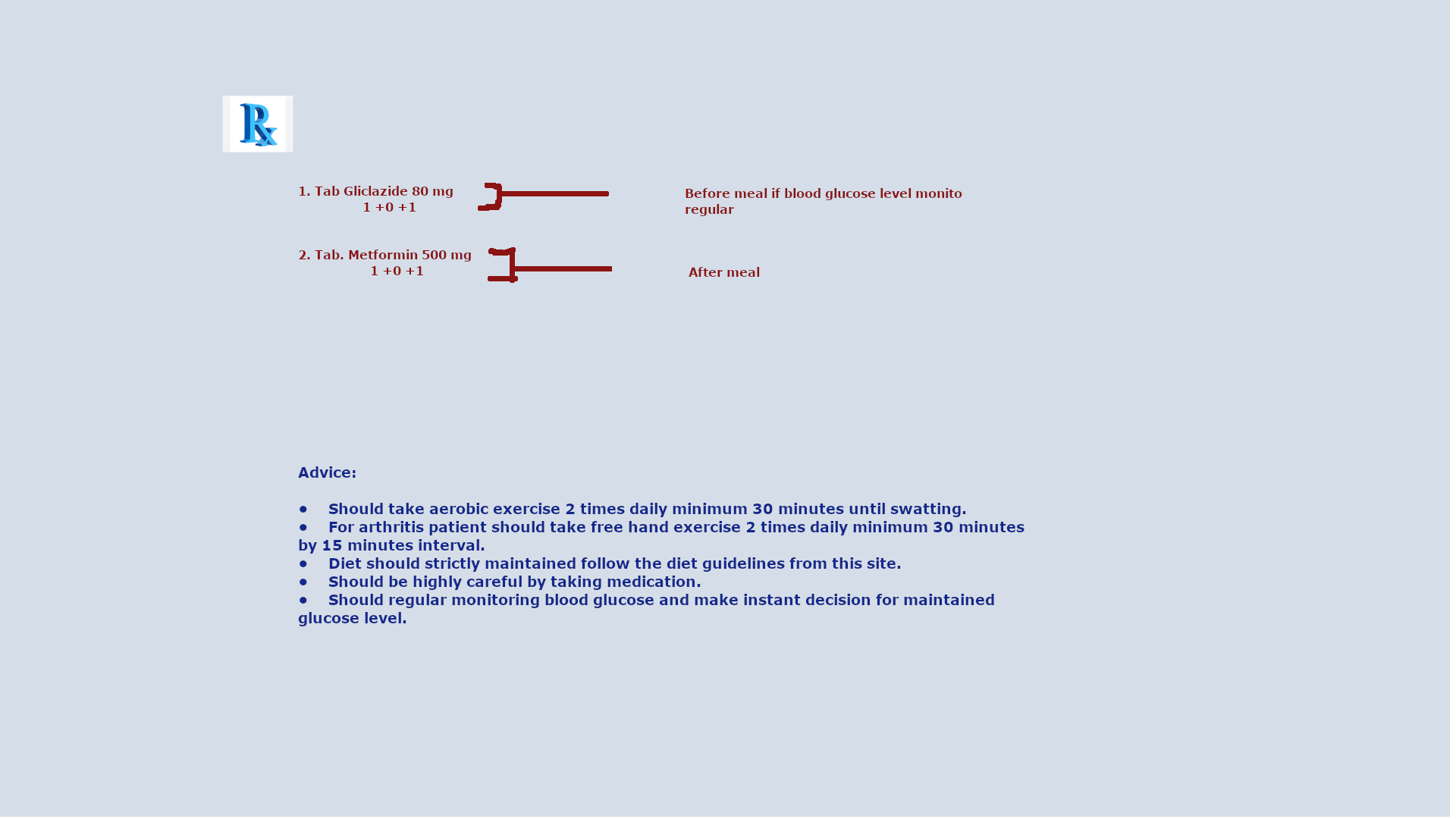
Note: Dose should be adjustment according with blood glucose level. If your self measurement FBG bellow 7 mmol/L and ABS bellow 11 mmol/L or HbAc1 bellow 6.5% you should reduce dose in single dose metformin 500 mg a day or avoid medicine and by strictly diet control with exercise .
If your self measurement FBG range with 7 mmol/L and ABS within range 11 mmol/L or HbAc1 within range 6.5% you should reduce dose in single dose Glicalazid 80mg at morning & metformin 500 mg twice a day.
Prescription No 3 Contraindicated to the patient- Who are
- Should not prescribed for patients who have renal impairment eGFR < 45 ml per minute/1.73 m2.
- Should stop In anyone with an eGFR less than 30 ml per minute/1.73 m2.
- Should be considered as cardiac failure serial pulmonary insufficiency.
Prescription No 4
Apply for the patient condition – who are
- Moderate diabetics type two patient
- If HbAc1 range is 7.5% to 8.5 %.
- Who are a kidney disease patient.
By using self measurement of blood glucose level
- FBG= 12 to 16 mmol/l
- ABS=16 to 20 mmol/L
- 1 hours after 75g anhydrous ingestion.
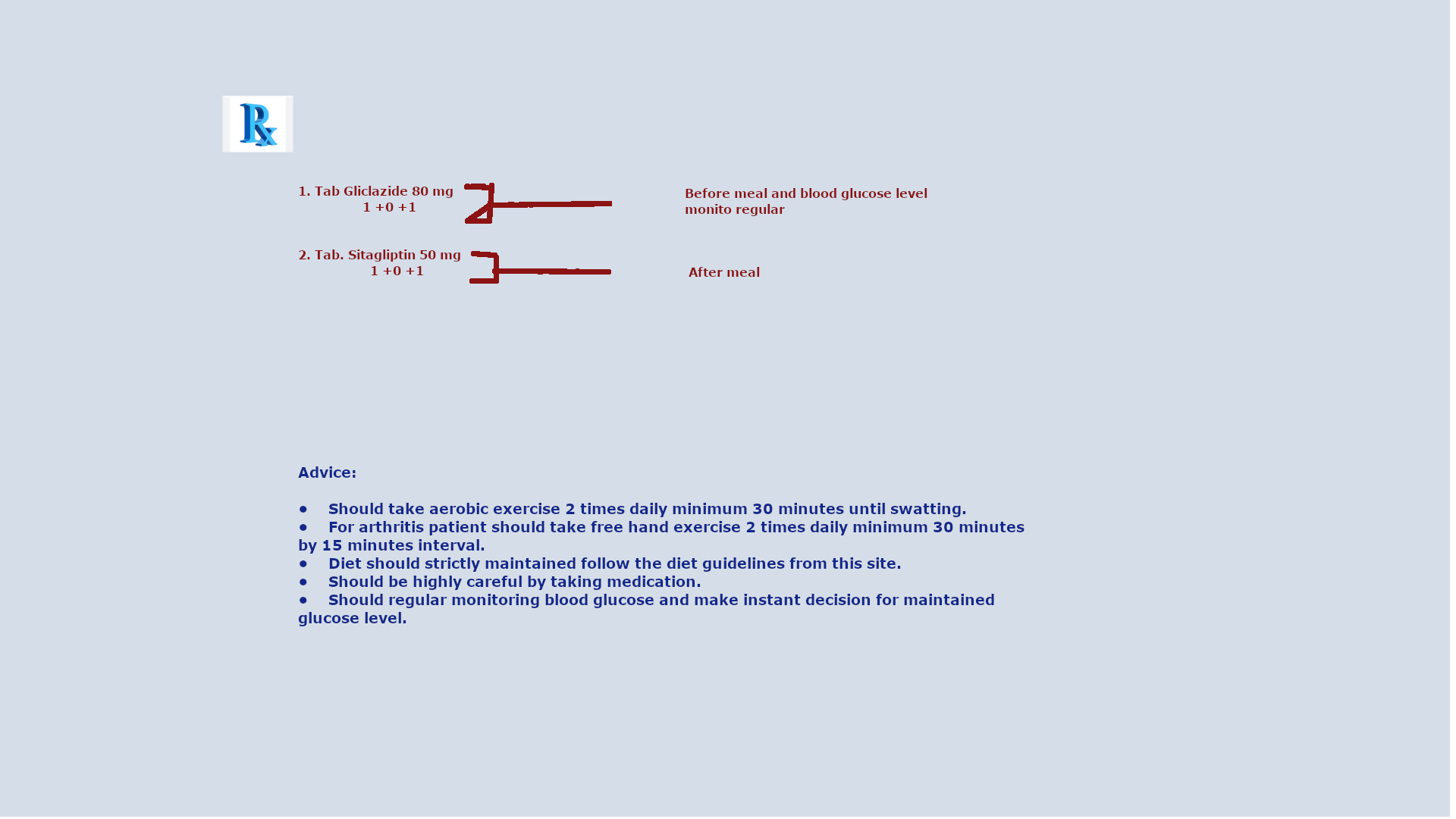
Note: Dose should be adjustment according with blood glucose level. If your self measurement FBG bellow 7 mmol/L and ABS bellow 11 mmol/L or HbAc1 bellow 6.5% you should reduce dose in single dose Glicalazid 30mg at morning in a day or avoid medicine and by strictly diet control with exercise .
If your self measurement FBG range with 7 mmol/L and ABS within range 11 mmol/L or HbAc1 within range 6.5% you should reduce dose in single dose Glicalazid 80mg at morning & Sitagliptin 50 mg once at night a day.
Prescription No 4 Contraindicated to the patient- Who are
- It is best selection medicine no other contraindicated though hypoglycemia is the major risk and should conscious about that.
- Sever liver disease patient ( acute or chronic liver cirrhosis).
Prescription No 5
Apply for the patient condition – who are
- Moderate diabetics type two patient
- If HbAc1 range is up to 8.5 %.
By using self measurement of blood glucose level
- FBG= Up to 16 mmol/l
- ABS=Up to 20 mmol/L
- 1 hours after 75g anhydrous ingestion.
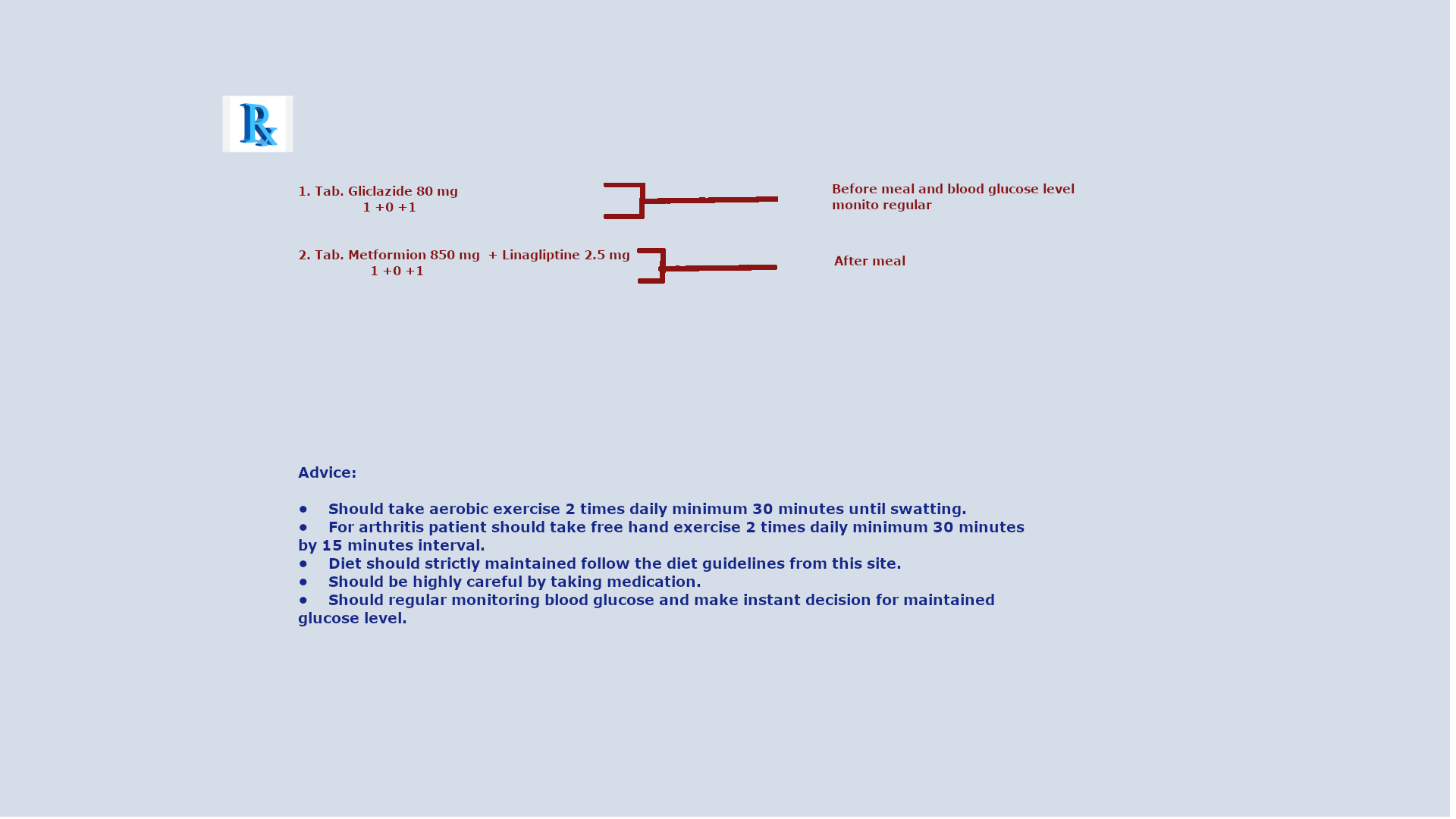
Note: Dose should be adjustment according with blood glucose level. If your self measurement FBG bellow 7 mmol/L and ABS bellow 11 mmol/L or HbAc1 bellow 6.5% you should reduce dose in single dose Glicalazid 30mg at morning in a day or avoid medicine and by strictly diet control with exercise .
If your self measurement FBG range with 8.5 mmol/L and ABS within range 16 mmol/L or HbAc1 within range 7.5% you should reduce dose in single dose Glicalazid 80mg at morning & Metformin 500 mg with linagliptin 2.5 mg twice a day.
Prescription No 5 Contraindicated to the patient- Who are
- Should not prescribed for patients who have renal impairment eGFR < 45 ml per minute/1.73 m2.
- Should stop In anyone with an eGFR less than 30 ml per minute/1.73 m2.
- Should be considered as cardiac failure serial pulmonary insufficiency.
Prescription No 6
Apply for the patient condition – who are
- Moderate diabetics type two patient
- If HbAc1 range is up to 8.5 %.
- Who are a kidney disease patient.
By using self measurement of blood glucose level
- FBG= Up to 16 mmol/l
- ABS=Up to 20 mmol/L
- 1 hours after 75g anhydrous ingestion.
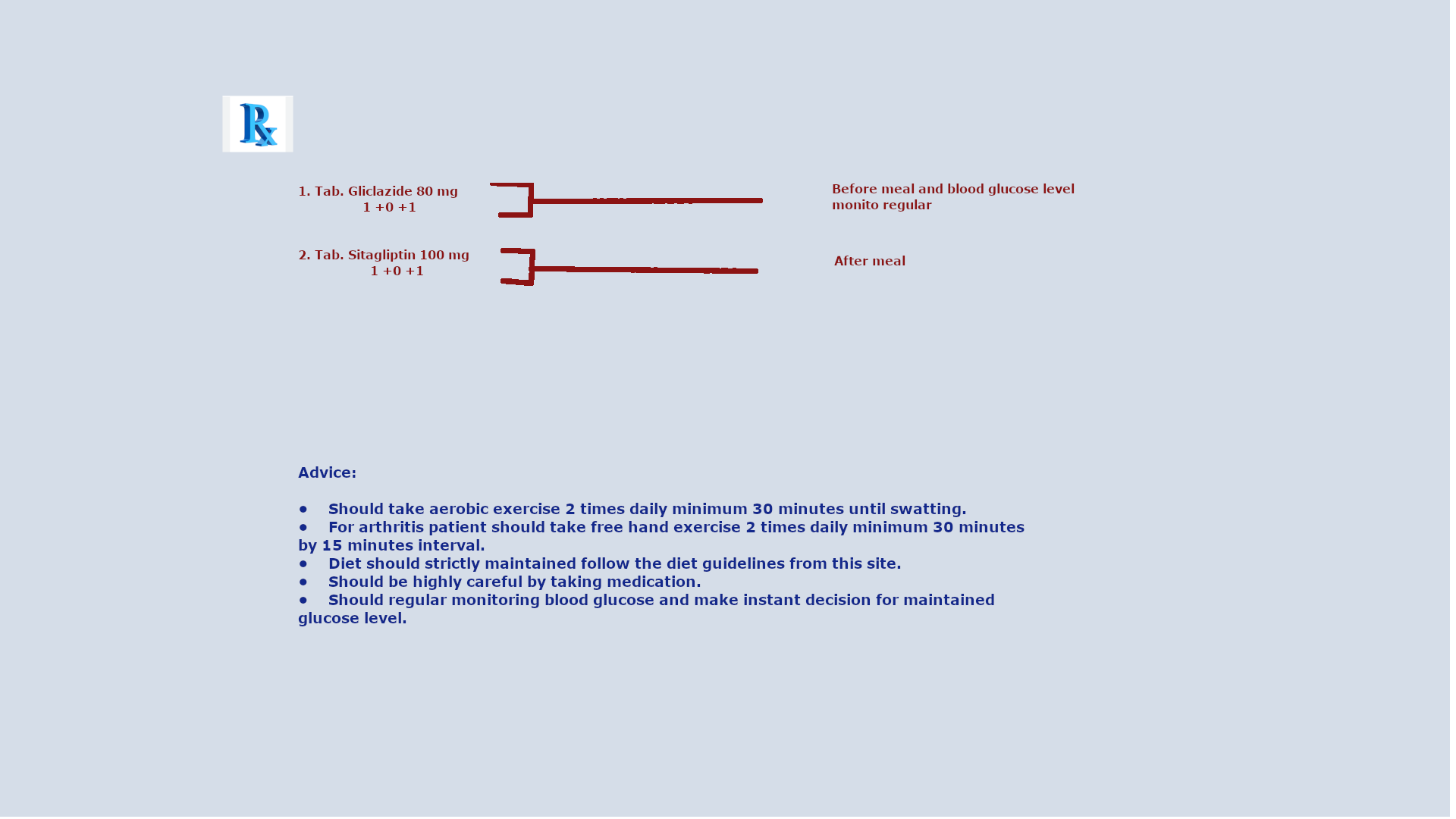
Note: Dose should be adjustment according with blood glucose level. If your self measurement FBG bellow 7 mmol/L and ABS bellow 11 mmol/L or HbAc1 bellow 6.5% you should reduce dose in single dose Glicalazid 30mg at morning in a day or avoid medicine and by strictly diet control with exercise .
If your self measurement FBG range with 8.5 mmol/L and ABS within range 16 mmol/L or HbAc1 within range 7.5% you should reduce dose in single dose Glicalazid 80mg at morning & Sitagliptin 50 mg twice a day.
Prescription No 6 Contraindicated to the patient- Who are
- It is best selection medicine no other contraindicated though hypoglycemia is the major risk and should conscious about that.
- Sever liver disease patient ( acute or chronic liver cirrhosis).
Insulin withdraw for type 2 diabetics patient
Insulin diffusion is a fear of some patient. Otherwise insulin in a protein drugs that may required highly dose maintaining. It may require increasing the dose. Sometime high dose become a risk of hypoglycemia that may cause an accident. I always suggest to avoid insulin administration if it is possible and haven’t other complication. You should gradually withdraw insulin by replacement with medicine.
You may follow the process for withdraw carefully step by step:
Step 1
- Calculate your insulin dose that you are use as administration.
- Divided the dose for two times if you administrate it one time( Example: Suppose you use 20 unite insulin as a single dose in the morning you should divided it 10 and 10 unites and administrate it morning and evening two times as double dos) .
- If you use insulin in two times a day you should unchanged as morning dose and should divided your evening dose as half and use medicine as replacement of 2nd half of insulin dose(( Example: Suppose you use 20 unite insulin in the morning and 30 unites in the evening as a double dose per day you should divided your evening dose as 15 and 15 unites and administrate only 15 units at evening and remaining 15 unites are divided by medicine).
- Continue the medication treatment for 15 days and monitoring your blood glucose level regularly.
- If you don’t face any major complication you should go 2nd
Step 2
- Now you use insulin in two times a day you should unchanged as morning dose and should replace means omit your evening insulin dose if necessary by using medicine as increasing dose.
- Continue the medication treatment for 15 days and monitoring your blood glucose level.
- If you don’t face any major complication you should go 3rd
Step 3
- Now you should divided your morning dose as half and use medicine as replacement of 2nd half of insulin dose and 2nd dose is totally replaced means omit your morning insulin dose if necessary my medicine before.
- Continue the medication treatment for 15 days and monitoring your blood glucose level.
- If you don’t face any major complication you should go 4th
Step 4
- Now you should replacement of 2nd half of insulin dose by medicine as increasing the dose and evening dose was replaced by medicine before.
Continue the medication treatment for 15 days and monitoring your blood glucose level.
Long term diabetes complications
Cardiovascular disease
- Myocardial infarction
- Hypertension
- Dyslipidemia
- Atherosclerosis
- Peripheral vascular disease
- Atherosclerosis cramping pain & reversible muscle pain.
Retinopathy
- Prevent should light control blood glucose and blood pressure.
- Early detected site may be saved by laser photo coagulation in advance case surgery required.
- Pregnancy may worse, moderate to sever retinopathy.
Nephropathy
In diabetic renal disease the kidney become enlarged, GFR initially increase then decrease and progress reduction of GFR. GFR diagnosis by albumin creatinine ratio.
protienurea
GRF -Male equal or greater than 2.5 mg per mmol and female 3.5 mmol.
Macroalbuminia
GRF =>30 mg/mmol at end stage 200 mg/mmol.
Medication
Should tight control of hyperglycemia and blood pressure. Drug may be treated- ACE inhibitor ( Enalapril) and ARBs ( olmesartan) are preferred by class.
